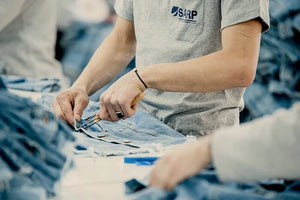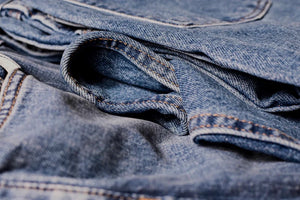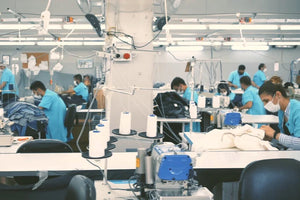Less is more
Apr 18, 2024
We are drowning in clothes. Every year, 100 billion garments are produced in a way that respects neither the planet nor the garment workers. In this article, we shed light on the problems of fast fashion and advocate a new way of thinking about how we shop.
The problem of overproduction is exacerbated by the culture of disposableness. Every second, a truckload of clothing is burned or buried in a landfill.
The problem has become so big that it can be seen from space. Below we want to introduce a new way of thinking about our purchasing habits as an antidote to overproduction and overconsumption.
At what price?
In a world where we can buy a T-shirt as cheaply as our coffee, it's easy to buy more. Unlike other things in our lives, fashion is one of the few industries that has gone down in price. In fact, the real price of clothing has halved since 1990. That means that, adjusted for inflation, we pay less for clothes today than our parents did.
This turns clothing - which used to be an investment - into a disposable item. Studies show that clothing is now thrown away after 7-8 wears. Their "affordability" makes it easy to think of clothing as a disposable item, something we can replace and throw away when we get bored or when it breaks.

But here's the inconvenient truth. Just because we pay less doesn't mean it's cheaper. This becomes obvious when we look at the cost relative to the use of the garment. We call it "cost per use" (CPP). It's the magic formula that simplifies your wardrobe - and your life - and frees up your budget for the things that really matter.
What are the costs per use?
"Cost per use" means breaking down the price according to how often you will actually wear the clothes. This principle has been displaced by fast fashion. Our purchases are now dictated by trends. At a price that you don't have to think much about. If the garment breaks after a few wears, it's no problem to just throw it away and replace it.
There is something wrong with this on many social and environmental levels. And that is why we are introducing the CPI, so that we can start measuring how much something actually costs over its life cycle.

Let us illustrate this with an example: If you invest €100 in a well-made shirt that you will wear once a week for the next three years, your KPN will be a very reasonable €0.64 (€100 : 52 weeks : 3 years).
If you compare it to a dispensable product that you rarely wear - for example, a €20 shirt that you only wear 10 times before the seams rip - then the KPN becomes €2. Contrasting the current price tag, you realise that the true cost is far more than what you paid for it.
There are also hidden external costs that we as consumers do not bear directly. These are the costs of the environmental pollution caused during production and the costs of disposing of the clothing. These costs must be borne by the societies that live in the countries where the clothing is manufactured and then disposed of. Incidentally, every year around 1.7 million tonnes of used clothing are exported from the EU to other countries in the world to be disposed of there!
Less is more
Have you ever noticed that it's harder to choose "less" than to get more? Every day we are bombarded with marketing that pushes the latest trends on us. This creates pressure to constantly buy new things and creates disposable clothing. Easy to buy, easy to throw away. Without much thought about the consequences.
KPN encourages us to think about how much something actually costs over its life cycle.

Image: TORLAND offers a repair service for the jeans it sells so that the products last as long as possible.
Investing in fewer but better items of clothing may be more expensive at first, but it will save you money in the long run. These long-lasting, high-quality items of clothing do more for you. This creates less waste, and your wallet will thank you.
"In a way, KPN is not so much a mathematical formula as a philosophy: less, but better."
Things that are made the right way. Things that you will feel good in. This simple change in thinking turns seemingly more expensive but more durable clothing into a cheaper choice in the long run.
The high price of fast fashion
Many people don't question what the clothes they buy are made of. How was it manufactured? How was the color dyed? And most importantly, under what conditions? The truth is that behind all the trends and glossy images there is a reality that we are not supposed to know about.
That 60% of our clothing worldwide is made of plastic, that 120 million trees are felled every year to produce it, and that the more than 8,000 chemicals used in dyeing cause the second biggest pollution of our drinking and industrial water. And the women and men who make them are paid a pittance for doing so.
This is the true cost of our clothing.

Image: Claudia Widlhofer and Sascha Hümbeli from the brand TORLAND are committed to long-lasting clothing
But does that mean we have to buy expensive things? The quick answer is no. Expensive doesn't mean it's ethical, because a high price doesn't always mean it's well made. Often the profit margin is just an incentive for more marketing and greenwashing.
So what can you do?
First, remember that the most sustainable clothes are the ones you have in your closet. Wear them as often as possible. Get creative with the combinations! Yes, it's OK to wear something your friends have already seen on Instagram.
Second, do your research before you buy. If you have to buy something, first find out how it was made. Find out what materials are included, how they were dyed and what happens to the wastewater. If you don't have time to research or can't find the information you're looking for, you can also rely on trustworthy certificates, such as the GOTS certificate . This takes both ecological and social standards into account.
Finally, ask yourself how long you will wear the garment. Is it a fad that you will wear once? Or is it a timeless piece that you will wear for years to come?
The KPN principle helps you to always focus on what is important.
Sources:
- Ellen MacArthur Foundation: https://www.ellenmacarthurfoundation.org/
- European Parliament: Environmental impacts of textile production and waste, https://www.europarl.europa.eu/topics/en/article/20201208STO93327/environmental-impacts-of-textile-production-and-waste-infographic
- Greenpeace: Background overproduction and destruction of goods, https://greenpeace.at/uploads/2023/07/20221019_hintergrundpapier_warenvernichtung.pdf




